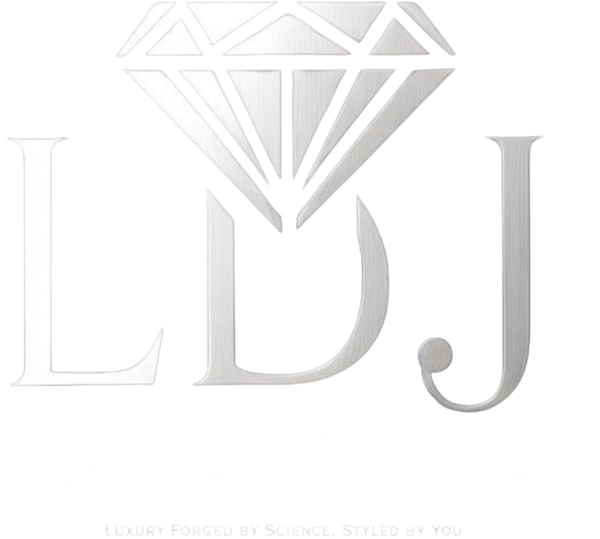If you are looking to get a diamond for a ring, a pendant, or a statement piece, you might be asking yourself a crucial question: Should you go for a lab-grown diamond or a natural one? Both of them provide beauty, brilliance, and value, however, there are certain differences between them that you have to know before making the decision.
With this most comprehensive buying guide, you will be able to grasp everything about the lab-grown diamonds and natural diamonds and make an informed choice that perfectly fits your needs, values, and budget.
What Are Lab-Grown Diamonds?
Lab-grown diamonds are produced in the laboratory under highly controlled conditions using advanced technologies that mimic the processes in the Earth’s mantle where natural diamonds are formed. They are also called synthetic or man-made diamonds.
How They’re Made:
-
HPHT (High Pressure High Temperature) or
CVD (Chemical Vapor Deposition)
Such procedures result in a diamond that is the same with natural diamonds chemically, physically, and optically.
What Are Natural Diamonds?

Natural diamonds are formed due to the extreme heat and pressure in the Earth over a billion years. Mining brings them up from the Earth's crust and they are rare because they are natural and have taken a very long time to be created.
|
Feature |
Lab-Grown Diamonds |
Natural Diamonds |
|
Origin |
Laboratory-created |
Earth-mined |
|
Formation Time |
Weeks to months |
Billions of years |
|
Cost |
More affordable |
More expensive |
|
Environmental Impact |
Low (no mining) |
High (mining, land disruption) |
|
Resale Value |
Lower |
Higher in traditional markets |
|
Ethical Sourcing |
Conflict-free |
May involve conflict zones |
|
Grading |
GIA, IGI, GCAL |
GIA, IGI, AGS |
|
Visual Differences |
None to the naked eye |
None to the naked eye |
How to Choose the Right Diamond for You
1. Set Your Budget
If you were looking for a bigger diamond and at the same time saving money, lab-grown diamonds have more brilliance for the same amount of money.
2. Check Your Values
If sustainability, traceability, and ethics are at the core of your values, then going for lab-grown is the best decision. Looking for a diamond that is unique and at the same time one of the most beautiful? Choose natural.
3. Purpose of the Diamond
- For everyday wear or engagement: Example of using lab-grown diamonds is when you want to have a beautiful and affordable ring.
- For legacy or investment: Natural diamonds are more likely to be a good option for an investment that will appreciate over time.
4. Certification Matters
Make sure any diamonds you buy—lab or natural—come with certification from such well-established organizations as the GIA (Gemological Institute of America) or IGI (International Gemological Institute) So you get the quality and authenticity assured.
Common Myths Debunked
Myth: Lab-grown diamonds are fake.
Truth: Lab diamonds are not fakes; they have the same chemical and physical structure as mined ones.
Myth: Natural diamonds are always better.
Truth: Your choice matters the most. Lab diamonds give the same look and quality but for a lower price.
Myth: You can easily tell them apart.
Truth: Jewel
- Hip-hop jewelry (flashy chains, pendants, rings)
- Engagement rings within a budget
- Ethical gift-giving
- Natural Diamonds Are Popular For: Heirloom pieces High-end
Eco-Friendly & Ethical Considerations
Why Lab-Grown Diamonds Appeal to Modern Buyers:
- Eco-conscious: No impact on the land, water, or animals.
- Conflict-free: No connection with unethical labor or illegal areas.
- Traceable: Clear and open supply chain.
Natural Diamonds Can Also Be Ethical:
- Choose natural diamonds with Kimberley Process certification that is a program attempting to exclude illegal diamonds from being traded.
Resale & Insurance Considerations
Resale Value:
- Natural diamonds have a history of being more likely to sustain money value.
- Lab-grown diamonds are still new in the resale market, but the fact that they are cheaper makes it easier for many consumers.
Insurance:
- Both lab-grown and natural diamonds may be covered by insurance.
- Make sure you possess a lab report (IGI, GIA, etc.) and a check to determine the value.
Final Thoughts
If you decide to buy a lab-grown or natural diamond, the idea is to select the one that suits your lifestyle, beliefs and personality. Lab-grown diamonds provide you with the best value, are eco-friendly, and have great brilliance, while natural diamonds are associated with tradition, scarcity, and the classic look.
We at give you the option of either certified lab-grown or natural diamonds, tailored to your requirements—so you can always have both shine and meaning.
Ready to Choose Your Diamond?
Explore our collection of certified lab-grown and natural diamonds:
Shop Now on www.labgrowndiamjewel.com
Frequently Asked Questions (FAQs)
Q1. Are lab-grown diamonds real?
A: Of course! Lab-grown diamonds are chemically, physically, and optically the same as mined diamonds. They are real diamonds—no fakes.
Q2. Can anyone tell the difference just by looking?
A: Absolutely not. Even the experts cannot identify lab-grown ones without special instruments.
Q3. Do lab-grown diamonds get certified?
A: Sure. Reputable labs like IGI, GIA, and GCAL issue certificates for lab-grown diamonds.
Q4. Are natural diamonds worth more in the long run?
A: Usually, yes—especially if it is a big or a rare diamond. Apart from that, however, the affordability and ethical value of lab-grown diamonds are the reasons why they are leading the present buying trend.
Q5. Can I resell a lab-grown diamond?
A: You may do so, but the price at which you would be

